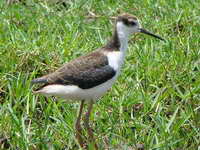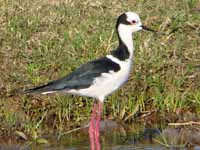THE WORLD BIRDS - An Online Bird Book
SHOREBIRDS
Avocets and Stilts
Order Charadriiformes Family Recurvirostridae
SHOREBIRDS
Most Shorebirds walk along shores probing for food with their thin sensitive bills. Bill length varies considerably so differing species can work the same shore and obtain different
food supplies. Shorebirds include sandpipers, godwits, stilts, oystercatchers, plovers, and many more. Shorebirds belong to the Charadriiformes order which also includes the Gulls
and Allies.
Note: the term Shorebirds is used in the Americas; elsewhere "waders" is used. We will reserve "waders" for herons and allies.
Some Charadriiformes families:
Burhinidae: thick-knees; Charadriidae: small plovers, lapwings; Glareolidae: courses, pratincoles; Haematopodidae: oystercatchers
Jacanidae: jacanas; Recurvirostridae: avocets, stilts; Scolopacidae: small bill sandpipers, large bill sandpipers
.Note: the term Shorebirds is used in the Americas; elsewhere "waders" is used. We will reserve "waders" for herons and allies.
Some Charadriiformes families:
Burhinidae: thick-knees; Charadriidae: small plovers, lapwings; Glareolidae: courses, pratincoles; Haematopodidae: oystercatchers
Jacanidae: jacanas; Recurvirostridae: avocets, stilts; Scolopacidae: small bill sandpipers, large bill sandpipers
Avocets and Stilts
Order Charadriiformes Family Recurvirostridae
Avocets and stilts have very long thin legs and long bills. The stilt bills are straight, while avocet bills are curved upward. Avocets and stilts are aprroximately the same height and often can be found in mixed groups.
Genus Recurvirostra
Avocet, American Recurvirostra americana Found: North America
The American Avocet has long, thin, gray legs. The back is black and white and underbelly white. The neck and head are cinnamon colored in the summer and gray in the winter. The long, thin bill is upturned at the end.
Image by: 1) Becky_Matsubara - CA 2, 4) Kevin Cole 5) Alan D. Wilson - California 6) Dick Daniels - North Carolina
3, 6) Charlie Westerinen - the Lida Junction airport in Nevada
1, 2, 3) Breeding 4, 5) Nonbreedings
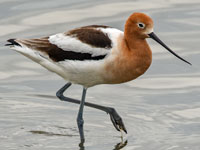
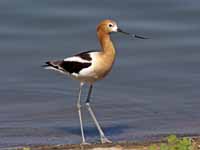
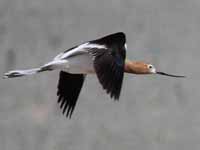
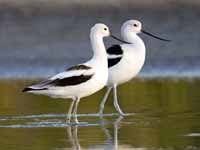
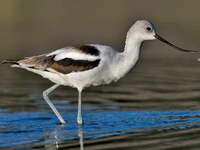
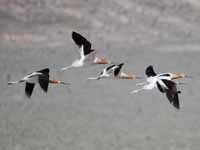
Avocet,_Andean Recurvirostra andina Found: Argentina, Bolivia, northern Chile, southern Peru
The Andean Avocet has dark brown back, wings, tail; white head, neck, underparts; gray legs.
Image by: 1) Till Niermann - Chile 2) lalo_pangue - Chile 3) Nick_Athanas
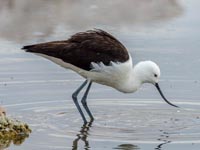
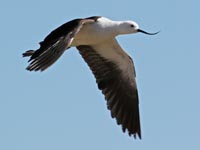
Avocet, Pied Recurvirostra avosetta Found: Europe, Asia, Africa
The Pied Avocet is black and white. It has a completely black hood; blueish legs.
Image by: 1, 3, 4, 5, 7) Dick Daniels - Sylvan Heights
2) Sandy Cole - Sylvan Heights 6) Cristiano Crolle - Namibia 8) Andi_Li5) Pre mating 7) Comparison between Pied Avocet and Black-necked Stilt
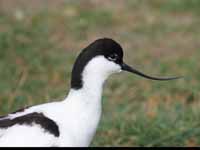
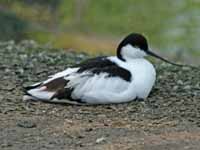
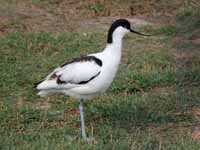
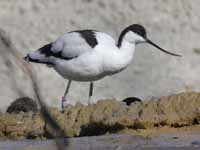

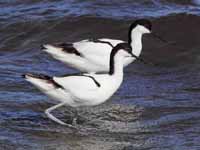
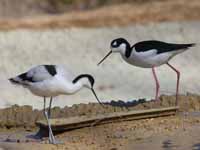
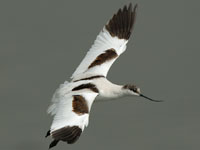
Avocet, Red-necked Recurvirostra novaehollandiae Found: Australia
The Red-necked Avocet has chestnut brown head and neck; black bill; gray-blue legs; black and white wings; white rest of body.
Image by: 1) Grahame - Rottnest Island 2,3, 4) JJ Harrison

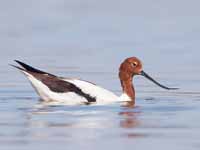
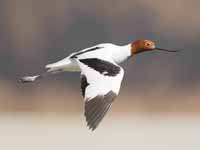
Genus Cladorhynchus - 1 species
Stilt,_Banded Cladorhynchus leucocephalus Found: Australia
The Banded Still is entirely black and white, except when breeding and then it has a dark chestnut breast band. It has pink legs, relatively short for a stilt.
Similar to: Black-winged Stilt. Ranges do not overlap.
Similar to: Pied Stilt. Banded Stilt has breast band in breeding season. Pied Stilt has nape patch.
Image by: 1) Helenabella - Rottnest Island (off coast of western Australia) 2) Nick Talbot 3) birdsaspoetrySimilar to: Black-winged Stilt. Ranges do not overlap.
Similar to: Pied Stilt. Banded Stilt has breast band in breeding season. Pied Stilt has nape patch.
1, 2) Breeding
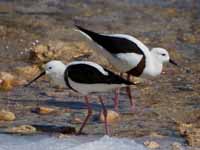
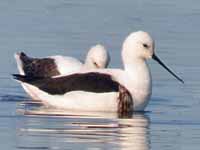
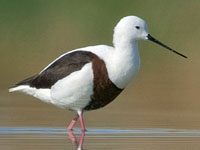
Genus Himantopus
Stilts have extremely long legs, hence the name, and long thin bills. Stilts typically feed on aquatic insects and other small creatures and nest on the ground surface in loose colonies. They are found in brackish or saline wetlands in warm or hot climates.
Similar to: Avocets. Avocets have long legs, but shorter than stilts. Also, avocets have up-turned bills; stills have straight bills.
Stilt,_Black Himantopus novaezelandiae Found: New Zealand
The Black Stilt is the only stilt that has entirely black plumage. It is very rare - approximately 100 birds.
Image by: 1) Dick Daniels - Kiwi Birdlife Park, New Zealand 2) Yang Zhang 3) Eric_de_Leeuw
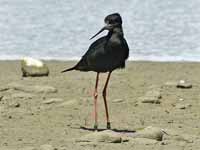
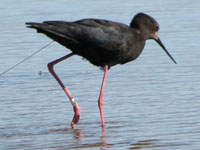
Stilt,_Black-necked Himantopus mexicanus Found: southern North America to north Peru and northeast Brazil.
The Black-necked Still Head has white head; black cap which extend below eye; white spot above eye; black nape; white underparts. Usually no white band across upper back.
Similar to: Hawaiian Stilt. The black on Hawaiian Stilt's head usually extends lower below the eye than the black on a Black-necked Stilt.
Similar to: White-backed Stilt. The Black-necked Stilt and White-backed Stilt sometimes form hybrids. Only a pure Black-necked Stilt should have a white spot above the eye. Usually only White-backed Stilt has white collar across upper back.
The Black-necked Stilt is sometimes treated as a subspecies of the Black-winged Stilt. In this case it would be identified as Himantopus himantopus mexicanus.
Image by: 1) New Jersy Birds - California 2) Dick Daniels - the Galapagos Islands
3) Dick - St John Island, Virgin Islands
4, 5) Dick - Sylvan Heights 6) Sandy Cole - Sylvan Heights 7, 8, 9) Dick - La Laguna, ChileSimilar to: Hawaiian Stilt. The black on Hawaiian Stilt's head usually extends lower below the eye than the black on a Black-necked Stilt.
Similar to: White-backed Stilt. The Black-necked Stilt and White-backed Stilt sometimes form hybrids. Only a pure Black-necked Stilt should have a white spot above the eye. Usually only White-backed Stilt has white collar across upper back.
The Black-necked Stilt is sometimes treated as a subspecies of the Black-winged Stilt. In this case it would be identified as Himantopus himantopus mexicanus.
1) Juvenile
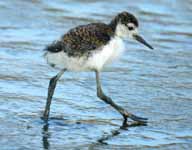
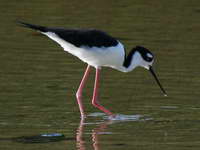
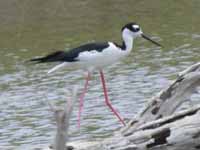
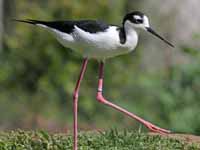
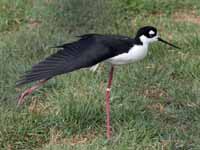

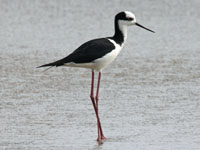

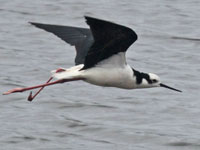
Stilt,_Black-winged Himantopus himantopus Found: Europe, Asia, Africa
The head and neck vary from all white to black cap and nape.The wings are all black. No other stilts in its range.
Similar to: Banded Stilt. Ranges do not overlap.
The Black-winged Stilt is sometimes treated as having subspecies. In this case, the Black-winged Stilt would be identified as Himantopus himantopus himantopus. The related (sub)species are: Black-necked Stilt,_Hawaiian Stilt, Pied Stilt, and White-backed Stilt.
Image by: 1) Alnus - Changhua County, Taiwan 2) JM
Garg - Faridabad District of Haryana, India 3) Frankie Chu 4, 5, 6) Dick Daniels - Tanzania 7) Gary Mercier - Cabo Verde 8) Andy_Li - Hong KongSimilar to: Banded Stilt. Ranges do not overlap.
The Black-winged Stilt is sometimes treated as having subspecies. In this case, the Black-winged Stilt would be identified as Himantopus himantopus himantopus. The related (sub)species are: Black-necked Stilt,_Hawaiian Stilt, Pied Stilt, and White-backed Stilt.
1) Female in front, male in rear 8) This has considerable black on the head.
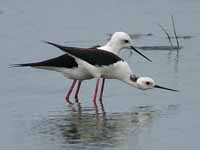
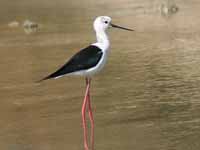
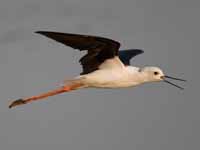


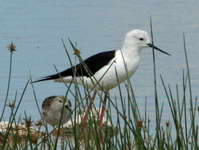
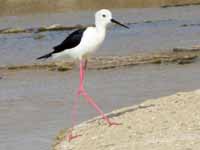
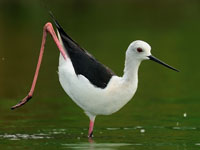
Stilt, Hawaiian Himantopus knudseni Found: Hawaii
The Hawaiian Still has substantial black on its head and neck.
Similar to: Black-necked Stilt. The black on Hawaiian Stilt's head usually extends lower below the eye than the black on a Black-necked Stilt.
The Hawaiian Stilt is sometimes treated as a subspecies of the Black-winged Stilt. In this case it would be identified as Himantopus himantopus knudseni. One neat place to find the Hawaiian Stilt is in Hanalei, made famous in the song Puff the Magic Dragon who lived in Hanalei.
Image by: 1, 2, 3)Dick Daniels - Kauai, Hawaii 4, 5, 6, 7) Dick - Maui, Hawaii.Similar to: Black-necked Stilt. The black on Hawaiian Stilt's head usually extends lower below the eye than the black on a Black-necked Stilt.
The Hawaiian Stilt is sometimes treated as a subspecies of the Black-winged Stilt. In this case it would be identified as Himantopus himantopus knudseni. One neat place to find the Hawaiian Stilt is in Hanalei, made famous in the song Puff the Magic Dragon who lived in Hanalei.
The size of a Hawaiin Stilt can be appreciated by comparing it to a Koala (Hawaiin Duck) in 6) while realzing how much of the stilt's legs are underwater.
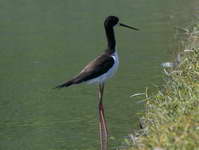

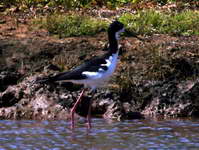
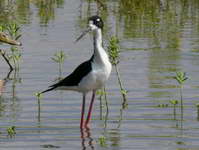
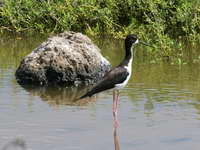
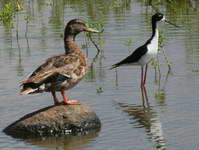
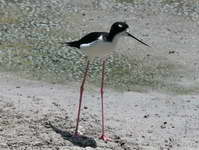
Stilt,_Pied also White-headed Stilt (in Australia also Black-winged Stilt) Himantopus leucocephalus Found: Australasia
The Pied Stilt has black wing; white forehead; fore-neck; underparts; black back, wings, nape patch; red eyes; pink legs.
Similar to: Banded Stilt. Banded Stilt has breast band in breeding season. Pied Stilt has nape patch.
The Pied Stilt is sometimes treated as a subspecies of the Black-winged Stilt. In this case it would be identified as Himantopus himantopus leucocephalus.
Image by: 1) Brett Donald 2) JJ_Harrison 3) Graham_Winterflood 4) Kotare - New Zealand 5) Ann Devereux Similar to: Banded Stilt. Banded Stilt has breast band in breeding season. Pied Stilt has nape patch.
The Pied Stilt is sometimes treated as a subspecies of the Black-winged Stilt. In this case it would be identified as Himantopus himantopus leucocephalus.
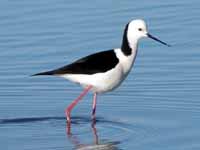

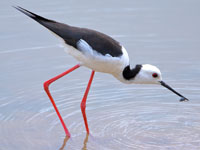
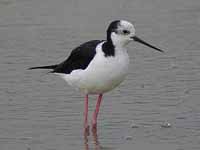
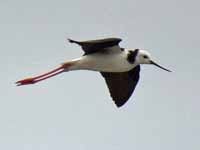
Stilt,_White-backed Himantopus melanurus Found: South America
The White-backed Stilt has white crown, white collar across upper back (hence its name); white underparts; pink legs.
Similar to: Black-necked Stilt. The Black-necked Stilt and White-backed Stilt sometimes form hybrids. Only a pure Black-necked Stilt should have a white spot above the eye. Usually only White-backed Stilt has white collar across upper back.
The White-backed Stilt is sometimes treated as a subspecies of the Black-winged Stilt. In this case it would be identified as Himantopus himantopus melanurus.
Image by: 1, 2) Cláudio Timm - Rio Grande do Sul, BrazilSimilar to: Black-necked Stilt. The Black-necked Stilt and White-backed Stilt sometimes form hybrids. Only a pure Black-necked Stilt should have a white spot above the eye. Usually only White-backed Stilt has white collar across upper back.
The White-backed Stilt is sometimes treated as a subspecies of the Black-winged Stilt. In this case it would be identified as Himantopus himantopus melanurus.
1) Juvenile
